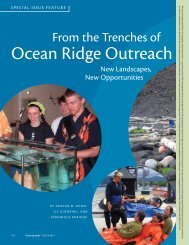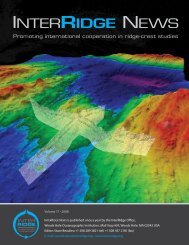Full version, low resolution, 7.5MB - InterRidge
Full version, low resolution, 7.5MB - InterRidge
Full version, low resolution, 7.5MB - InterRidge
You also want an ePaper? Increase the reach of your titles
YUMPU automatically turns print PDFs into web optimized ePapers that Google loves.
Workshops and Conferences<br />
The metal potential of a s<strong>low</strong>-spreading ridge segment<br />
GEOMAR, Kiel, Germany, 19-20 April 2012<br />
Convenor: Sven Petersen; Report by John Jamieson, Univ. of Ottawa, Canada<br />
This workshop, hosted by GEOMAR, brought together scientists<br />
with backgrounds in geology, geophysics, modeling and engineering,<br />
but who all had an interest in hydrothermal mineralisation processes<br />
at s<strong>low</strong>-spreading ridges. Thirty-three participants from 8 countries<br />
attended the workshop. The goal of the workshop was to develop<br />
a framework for an integrated study of the metal content of a s<strong>low</strong>spreading<br />
ridge segment with a multi-disciplinary approach that<br />
combines geological and geophysical studies and uses the latest<br />
technological advances in marine surveying.<br />
The proposed study relies on the use of multiple surveying<br />
platforms and techniques, including rock sample and fluid collection,<br />
visual reconnaissance, ship and AUV-based high-<strong>resolution</strong><br />
mapping, and geophysical surveys along and across the spreading<br />
axis. The goal is to produce various high-<strong>resolution</strong> geological and<br />
geophysical surveys of an entire ridge segment in order to calculate<br />
the full metal budget of a ridge segment and its variability with time.<br />
The integration of these various sources of information will be used<br />
to constrain the proportion of metals transported to the seafloor<br />
by hydrothermal fluids along the length of a ridge that are either<br />
deposited as massive sulfides, or dispersed over a wider area by the<br />
hydrothermal plume, or dissolved back into seawater. The area<br />
chosen for this study is the TAG segment on the Mid-Atlantic Ridge<br />
that hosts known active and inactive hydrothermal systems.<br />
MarVeL Workshop catalyzes new international collaborations for<br />
studies of connectivity between deep-sea vents<br />
Okinawa Institute of Science and Technology, 10-11 May 2012<br />
Convenors: Stace Beaulieu, Woods Hole Oceanographic Institution, Woods Hole, MA 02543 USA (stace@whoi.edu)<br />
Satoshi Mitarai, Okinawa Institute of Science and Technology, Onna, Okinawa 904-0495 JAPAN (satoshi@oist.jp)<br />
Hiromi Watanabe, Japan Agency for Marine-Earth Science and Technology, Yokosuka, Kanagawa 237-0061 JAPAN (hwatanabe@jamstec.go.jp)<br />
Despite three decades of research on deep-sea hydrothermal vents,<br />
larval dispersal and population connectivity between these discrete<br />
and extreme habitats remain poorly understood. Connectivity, which<br />
occurs on time scales of one to several generations, is what<br />
ultimately drives the biogeography of the species endemic to<br />
hydrothermal vents. Understanding connectivity between vents<br />
requires expertise from multiple disciplines, including biology,<br />
physical oceanography and the geo-sciences. The Mariana Vent<br />
Larvae (MarVeL) Workshop: International Study of<br />
Connectivity Between Hydrothermal Vents was held 10-11 May<br />
2012 in Okinawa, Japan, at the Okinawa Institute of Science and<br />
Technology (OIST) (http://marvelworkshop.whoi.edu). The<br />
workshop was convened by Stace Beaulieu (WHOI), Satoshi Mitarai<br />
(OIST) and Hiromi Watanabe (JAMSTEC) and funded by the U.S.<br />
National Science Foundation (NSF Grant #1157556) and OIST.<br />
Two main objectives of the workshop were to: 1) Share state-ofthe-art<br />
methods and data for studies of larval dispersal and<br />
population connectivity of deep-sea vent fauna in regions currently<br />
being investigated by U.S., Japanese and other PIs, and 2) Develop<br />
a coordinated research plan to study connectivity between<br />
hydrothermal vents in the western Pacific, specifically considering<br />
the Mariana arc and back-arc.<br />
Workshop participants were recruited by the conveners, with the<br />
aim to balance disciplinary interests and nationalities, and special<br />
consideration was given to early career researchers including<br />
postdocs and students. The workshop had a total of 35 participants<br />
(18 Japan, 14 U.S., 2 Canada, 1 France) and an additional 5<br />
participants via EVO web conferencing (2 U.S., 1 Japan, 1 France, 1<br />
Korea). This total of 40 participants included 13 postdocs and<br />
students who received training and guidance for effective<br />
collaboration with researchers from diverse backgrounds (Fig.1).<br />
One of the postdocs, S. Arellano, said, “It was really valuable to<br />
meet the many other researchers from around the U.S., France,<br />
Canada and Japan. The small workshop setting gave me a chance to<br />
talk to many researchers in a way that I wouldn’t be able to if we<br />
INTERRIDGE NEWS 57 VOL.21, 2012
















